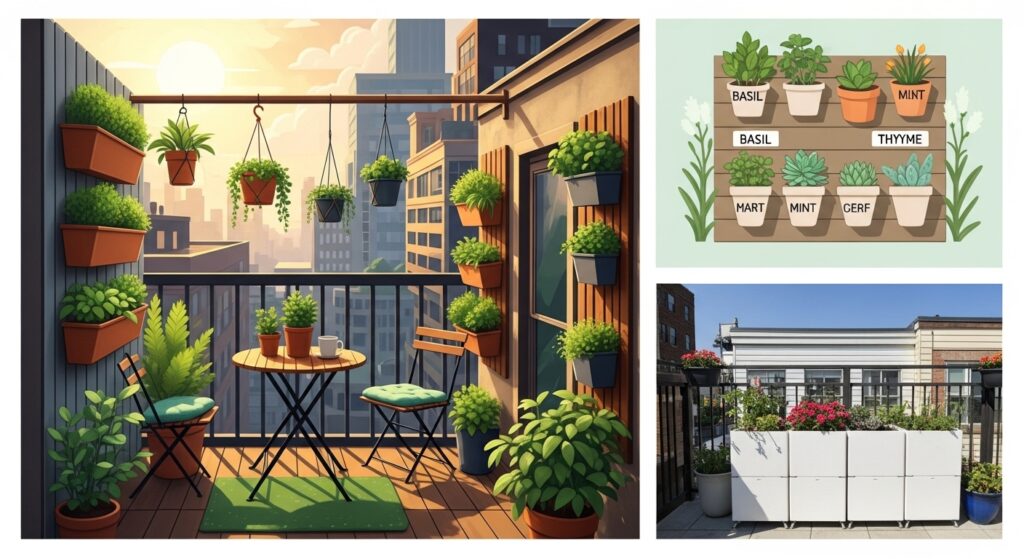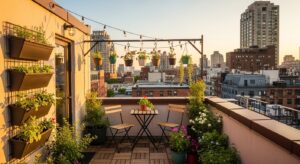Urbanization changes cities fast, leaving little space for nature. Rooftop gardens have started a revolution in bringing back urban greenery to this concrete jungle. You have many chances to enjoy small space gardening on rooftops, even in tiny spaces. You might want to grow your veggies, make a quiet getaway, or help with sustainability.
This complete guide gives expert tips on how to design rooftop gardens, and it looks at the best rooftop gardening ideas made just for small city settings.
What are rooftop gardens?
Rooftop gardens are green areas built on top of homes, businesses, or factories. These gardens can serve a purpose or just look nice. They range from basic landscapes with soil beds, watering systems, and even pergolas to simple potted plants. Rooftop gardens offer a way to bring a bit of nature into tight city spaces where backyards are rare.
Why Rooftop Gardens Are Catching On
Gardens on rooftops aren’t just a passing trend. They offer real perks and help solve big city problems:
- Maximize Limited Space: When ground-level space is scarce, rooftops become prime spots for gardens.
- Enhance Air Quality: Plants act as natural air filters, cleaning city air of pollutants.
- Improve mental health: Green areas help to reduce stress levels and boost mood.
- Reduce Urban Heat: Rooftop plants help to lower surrounding temperatures, fighting the urban heat island effect. Growing your own herbs, fruits, and veggies lessens your need for store-bought produce and boosts sustainability.
These benefits make rooftop gardens a crucial answer to city living challenges.
The Best Rooftop Gardening Ideas for Small Spaces in the City
1. Grow Up, Not Out:
When you don’t have much floor space, think upwards. Vertical gardens let plants climb up trellises, wall planters, or hanging pots. They’re great for small rooftops and can hold herbs, veggies, flowers, and even vines.
Expert tip: You can set up old wooden pallets or modular vertical systems. To water everything, put it in a drip irrigation system.
2. Gardening in containers:
One of the easiest and handiest ways to start a rooftop garden involves containers. This method has an impact on plant growth in boxes, tubs, or pots. This setup works well for roofs that can’t hold much weight and allows for easy moves and swaps with the seasons.
Best Container-Friendly Plants: Cherry tomatoes, Mint, thyme, and basil. Also, small citrus trees, Spinach and lettuce.
Expert tip: To protect and keep plants cool in direct sun, pick containers that weigh less and can stand up to UV rays.
3. Structure and Use of Raised Garden Beds:
Planting in raised beds has a greater impact on soil control and drainage than planting directly in rooftop soil. Also, they make gardening easier for people with limited mobility by cutting down on bending.
Design Insight: Pick frames built from treated wood or metal to resist decay. To protect the roof surface and stop roots from growing through, put geotextile fabric on the bottom.
4. Grow Your Own Food in Edible Gardens:
A well-planned rooftop can turn into your personal edible paradise. Focus on fast-growing compact crops such as Lettuce, Raspberries, Blueberries, Chillies.
Sustainability Bonus: Growing your own food has an impact on reducing food miles, packaging waste, and the need to depend on produce filled with chemicals.
5. Herb Spirals: Artistic and Useful:
Herb spirals catch the eye and maximize microclimates to grow different herbs in a tight space. The base holds more moisture and gives shade, while the top stays dry and sunny.
DIY Tip: Plant herbs such as rosemary at the top and parsley at the bottom of a spiral mound built with bricks, rocks, or salvaged materials.
6. Integrate green roof systems with Architecture:
Green roofing covers roofs with soil layers, drainage systems, and waterproof membranes. It has an impact on insulation and boosts your property’s value over time, though it’s trickier and pricier to install.
Types:
- Extensive Green Roofs: Consist of grasses and moss
- Intensive Green Roofs: These roofs weigh more and can support a broader plant range, including small trees.
Expert Tip: To consider this option, check with a pro to ensure your roof can handle the extra weight.
7. Using pergolas and trellises:
To help climbing plants like jasmine, grapes, or ivy grow, build pergolas or trellises. Use wire mesh to grow vegetables such as beans and cucumbers.
These structures provide shade, enhance the look of your garden, and can act as privacy screens.
Uses for Creativity: Hang fairy lights to create a cozy feel at night.
8. Modular Plant Systems:
Modular garden systems consist of portable trays or blocks that connect like puzzle pieces. They offer design flexibility. People who rent or like to change their setup often find these systems useful.
Advantages:
- Easy to assemble and disassemble
- Lightweight choices for delicate roofs
- Great to include drip irrigation
9. Rooftop Tranquillity:
Water Features: Small water elements like tabletop fountains or recycled water walls can cool an area and create a calm environment.
Note: Water must never seep into the building’s structure unless it has proper drainage and containment.
10. Rooftop greenhouses:
Greenhouses help maintain temperature and humidity in colder climate,s allowing year-round gardening. Compact or DIY versions exist for small rooftops.
Points to remember:
- Polycarbonate panels provide strength and insulation
- Aluminum frames offer lightweight support
- Ventilation systems prevent overheating
A Step-by-Step Guide for Beautiful Rooftop Designs for Gardening
Designing a rooftop garden requires careful planning in compact urban areas.
Experts have approved this framework:
Step 1:Check the Roof’s Structural Strength
Talk to a structural engineer to find out how much weight the roof can hold before you add any plants or systems. Most roofs can support light containers without extra support, but not heavy soil beds.
Step 2:Make sure you have good drainage and waterproofing
Water can wreck your roof garden. Use root barriers and waterproof membranes, and set up drainage channels. Putting a layer of gravel or drainage mats under the soil can help a lot.
Step 3:Think about the sun and wind
Rooftops get a lot of wind and strong sunlight. Put up windbreaks like bamboo fences or lattices, or pick plants that can handle these conditions. Use UV-resistant covers when it gets hot.
Step 4:Plan your layout carefully and use zones
The green zone is where you grow plants and have plant beds.
Utility zone: to store water tanks and tools.
The lounge area: leisure zone serves as a space for seating or decorative elements. You can separate these zones with vertical elements.
Step 5:Pick plants that need little care
City folks often lead hectic lives with packed schedules. So choosing plants that thrive in your climate, resist pests, and tolerate drought will require less effort and minimal attention.
Examples:
- Succulents
- Lavender
- Ornamental grasses
- Native perennials
Step 6:Put it in a smart watering system
Hand watering wastes time and doesn’t water. Get a drip irrigation system with a timer. To save water, install a rain barrel to collect water.
Top Tips to Make the Most of Your Small Rooftop Garden
- Layer Your Space: To give depth and grow more, put planters on the floor, hang pots on walls, and hang pots at different heights.
- Go Multifunctional: Pick benches that store things or garden beds you can sit on, too.
- Rotate Crops: Switch up plant types each season to keep your soil healthy and productive.
- Make Use of Reflective Surfaces: Use mirrors or white walls to make the room seem bigger and brighten up dark spots.
- Implement Smart Lighting: Choose solar-powered or motion-sensor lights to cut down on energy use and let you garden after dark.
How to Tackle Common Problems in Rooftop Gardening
- Wind-related harm: Pick tough plant types, set up wind barriers, and tie down light pots.
- Maximum Weight Capacity: Go for light soil blends (like coco coir or perlite), avoid heavy ceramic pots, and spread the weight.
- Consistency in Watering: Self-watering pots or drip systems that work on their own can help plants grow well when you’re not around.
- Control of pests: Neem oil, a natural bug killer, and planting certain plants together (like marigolds with tomatoes) work well to keep pests away.
Inspiration from a Real-Life Rooftop Garden
Case Study: Small Rooftop Garden in New York A Brooklyn couple transformed their 300-square-foot rooftop into a compact garden oasis. They added tall planters, small fruit trees, and a cool dining spot. Using movable beds and old pallets, they built a space to grow herbs and greens. This tiny garden also gives them a place to relax after a long day.
Takeaway: Even the smallest rooftops can become flourishing gardens with smart design and plant choices.
Conclusion:
As more people move to cities, adding rooftop gardens to urban life isn’t just a luxury anymore – it’s essential. Whether you grow food, flowers, or just create a personal getaway, rooftop gardening helps city folks connect with nature again.
By looking into creative design ideas and learning how to create rooftop gardens, you can change even the tiniest rooftop into a green haven. The secret is in clever planning, eco-friendly practices, and being open to trying new things.
How Do You Picture Your Rooftop Garden?
Have you given rooftop transformation a shot? What hurdles or wins have you come across? Tell us your thoughts or suggestions in the comments below. We’re eager to hear about your city gardening journey!








